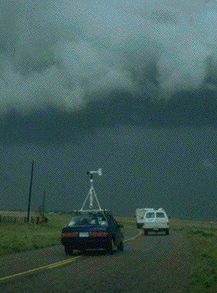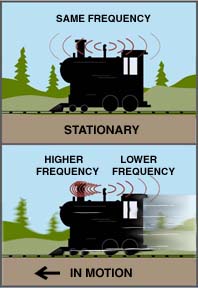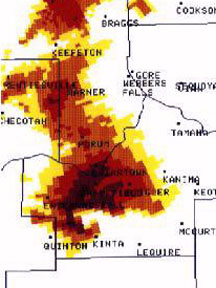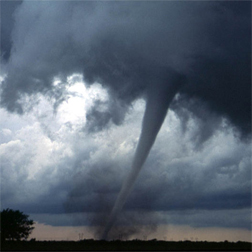Tornado observed by the VORTEX-99 team on May 3, 1999, in central Oklahoma. Note the tube-like condensation funnel, attached to the rotating cloud base, surrounded by a translucent dust cloud.
Click on image for full size
Courtesy of NOAA
Tornado Scales
Before 1971, there was no way for scientists to rank
tornadoes by their
strength. How big the tornado looked had no bearing on how strong it actually was.
In 1971, Professor Fujita came up with a system to
rank tornadoes according to how much damage they cause. This was called the Fujita Scale.
As of February 1, 2007, a new scale for rating the strength of tornadoes is being used. It is called the Enhanced Fujita Scale.
The Enhanced Fujita Scale or EF Scale has six categories from zero to five, with EF5 being the highest degree of damage. The Scale was used the first time as three separate tornadoes took place in central Florida early on February 2, 2007. These tornadoes destroyed many houses and businesses and killed at least 21 people. And these tornadoes were only rated EF3 tornadoes!
Scientists have to figure out how strong a tornado was after it hits.
Because the scale is based on the damage caused by it, they can't predict
how strong a tornado would be before it happens.
You might also be interested in:

How did life evolve on Earth? The answer to this question can help us understand our past and prepare for our future. Although evolution provides credible and reliable answers, polls show that many people turn away from science, seeking other explanations with which they are more comfortable.
...more
Tornadoes form from severe thunderstorms. They have a very high energy density which means that they affect a small area but are very destructive to that area. They also don't last very long which makes
...more
Tornadoes come in three different sizes, each with different characteristics. The three sizes are: weak, strong, and violent. Their size is based on how large the tornado is as well as the time that the
...more
Sound travels in waves. You hear sound because waves hit your ear. Sound waves are similar to ocean waves. They both have a certain frequency. The frequency is measured in hertz, which is one cycle per
...more
Storm chasers are different than storm spotters. Chasers travel around Tornado Alley looking for severe storms and tornadoes. This area in the Great Plains is the best for chasing because of the frequency
...more
A tornado is the most intense force in nature. That doesn't mean it's the most powerful. In fact, a thunderstorm can be 40,000 times more powerful than a tornado. Then why aren't thunderstorms as dangerous
...more
The Doppler effect was named after Christian Doppler, who first came up with the idea in 1842. He learned that sound waves would have a higher frequency if the source was moving toward the observer and
...more
It's hard to forecast tornadoes. They don't last very long and are also very complicated. Scientists don't really know how they form, but they do where they tend to form. Using what they know about the
...more















